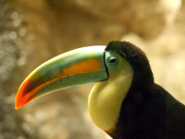Tuesday 28 March 2006
Bactrian camel - drinking 120 litres of water at a time!

The
Bactrian camel (
Camelus bactrianus) is native to the steppes of eastern Asia. As we all know a camel has two lumbs, and a dromedary has one. Contrary to popular belief, the lumbs are not used to store water for travelling in dry areas.
From Wikipedia: "Camels are well known for their humps. They do not store water in them as is commonly believed. Their humps are a reservoir of fatty tissue, while water is stored in their blood. However, when this tissue is metabolised, it is not only a source of energy, but yields through reaction with oxygen from the air 1111 g of water per 1000 g of fat. This allows them to survive without water for about two weeks, and without food for up to a month."
Compared to the dromedary, it is built for a more harsh life in the desert, the dromedary being taller an faster. A Bactrian camel can drink as much as 120 (!) litres of water at a time... The wild Bactrian camel population was first discovered by Przewalski, the same man who gave his name to the Przewalski horse.
Thanks to Thomas for pointing out that Camels do not store water in their humps.
Bactrian camel photographed by Jcwf, licensed under GNU Free Documentation License
You can help spreading the word about this animal by liking it on facebook
Permanent Link
Tuesday 14 March 2006
Toucans (Family Rhamphastidae) - A beak for (almost) all purposes

Everyone, who has ever seen a Toucan, surely was surprised by its huge beak. It is assumed that there are 37 Toucan species, all of them with more or less oversized beaks. Scientifically the Toucan family is called Rhamphastidae. It's striking that the relation between the size of the Toucan's beak and the size of its body increases with the size of the species. Small Toucan species have rather "normal" beaks, whereas the beaks of large species like the Toco toucan (Ramphastos toco) are huge, even if the size of the body is taken into consideration. The Keel-billed toucans (Ramphastos sulfuratus), shown on the photo, are among the medium sized species. The beak of this Toucan is very special for another reason; it is said to be the most colourful beak of all birds. The plummage of most Toucan species is very conspicuous too. Often black is dominant, but it's interrupted by colourful contrasting areas. Keel-billed toucans have a bright yellow chest for instance. The area around the eyes is without plummage and also very colourful in most species. Paradoxically the colourful plummage and the even more colourful beak are a perfect
camouflage in the treetops, since from a distance they make Toucans rather look like fruits than birds.
(more)
You can help spreading the word about this animal by liking it on facebook
Permanent Link
 The Bactrian camel (Camelus bactrianus) is native to the steppes of eastern Asia. As we all know a camel has two lumbs, and a dromedary has one. Contrary to popular belief, the lumbs are not used to store water for travelling in dry areas.
The Bactrian camel (Camelus bactrianus) is native to the steppes of eastern Asia. As we all know a camel has two lumbs, and a dromedary has one. Contrary to popular belief, the lumbs are not used to store water for travelling in dry areas. 
 Everyone, who has ever seen a Toucan, surely was surprised by its huge beak. It is assumed that there are 37 Toucan species, all of them with more or less oversized beaks. Scientifically the Toucan family is called Rhamphastidae. It's striking that the relation between the size of the Toucan's beak and the size of its body increases with the size of the species. Small Toucan species have rather "normal" beaks, whereas the beaks of large species like the Toco toucan (Ramphastos toco) are huge, even if the size of the body is taken into consideration. The Keel-billed toucans (Ramphastos sulfuratus), shown on the photo, are among the medium sized species. The beak of this Toucan is very special for another reason; it is said to be the most colourful beak of all birds. The plummage of most Toucan species is very conspicuous too. Often black is dominant, but it's interrupted by colourful contrasting areas. Keel-billed toucans have a bright yellow chest for instance. The area around the eyes is without plummage and also very colourful in most species. Paradoxically the colourful plummage and the even more colourful beak are a perfect
Everyone, who has ever seen a Toucan, surely was surprised by its huge beak. It is assumed that there are 37 Toucan species, all of them with more or less oversized beaks. Scientifically the Toucan family is called Rhamphastidae. It's striking that the relation between the size of the Toucan's beak and the size of its body increases with the size of the species. Small Toucan species have rather "normal" beaks, whereas the beaks of large species like the Toco toucan (Ramphastos toco) are huge, even if the size of the body is taken into consideration. The Keel-billed toucans (Ramphastos sulfuratus), shown on the photo, are among the medium sized species. The beak of this Toucan is very special for another reason; it is said to be the most colourful beak of all birds. The plummage of most Toucan species is very conspicuous too. Often black is dominant, but it's interrupted by colourful contrasting areas. Keel-billed toucans have a bright yellow chest for instance. The area around the eyes is without plummage and also very colourful in most species. Paradoxically the colourful plummage and the even more colourful beak are a perfect